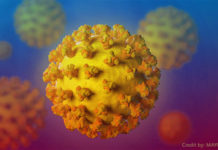Overview
Typhoid fever is caused by Salmonella typhi bacterium. infectious disease is rare in industrial countries. However, it remains a heavy health threat within the developing world, particularly for kids.
Typhoid fever spreads through contaminated food and water or through shut contact with somebody who’s infected. Signs and symptoms typically embrace a high fever, headache, abdominal pain, and either constipation or symptom.
What is typhoid?
- Typhoid bacterium 3d render
- Typhoid is AN infection caused by salmonella bacterium that’s unfold from human to human.
- Typhoid is AN infection caused by the bacteria salmonella (S. typhi).
The bacteria lives within the intestines and blood of humans. It spreads between people by direct contact with the excretion of AN infected person.
No animals carry this illness, therefore transmission is often human to human.
If untreated, around one in five cases of infectious disease will be fatal. With treatment, fewer than four in a hundred cases area unit fatal.
S. typhi enters through the mouth and spends one to three weeks within the bowel. After this, it makes its approach through the viscus wall and into the blood.
From the blood, it spreads into different tissues and organs. The system of the host will do very little to fight back as a result of S. typhi will live inside the host’s cells, safe from the system.
Typhoid is diagnosed by police investigation the presence of S. typhi via blood, stool, urine, or bone marrow sample.
Symptoms
Symptoms usually begin between half dozen and thirty days once exposure to the bacterium.
The two major symptoms of infectious disease area unit fever and rash. infectious disease is especially high, step by step increasing over many days up to 104 degrees Fahrenheit, or thirty-nine to forty degrees stargazer.
The rash, that doesn’t have an effect on each patient, consists of optimistic spots, notably on the neck and abdomen.
Other symptoms will include:
- weakness
- abdominal pain
- constipation
- headaches
- Rarely, symptoms may embrace confusion, diarrhea, and physiological reaction, however this can be not usually severe.
In serious, untreated cases, the viscus will become perforated. this may cause peritoneal inflammation, AN infection of the tissue that lines the within of the abdomen, that has been according as fatal in between five and sixty two p.c of cases.
Another infection, paratyphoid fever, is caused by enterics enterica. it’s similar symptoms to infectious disease, however it’s less possible to be fatal.
Symptoms
Signs and symptoms area unit possible to develop step by step — usually showing one to a few weeks once exposure to the illness.
Early ill health
Once signs and symptoms do seem, you are possible to experience:
- Fever that starts low and will increase daily, probably reaching as high as 104.9 F (40.5 C)
- Headache
- Weakness and fatigue
- Muscle aches
- Sweating
- Dry cough
Loss of craving and weight loss - Abdominal pain
- Diarrhea or constipation
- Rash
- Extremely swollen abdomen
- Later ill health
- If you do not receive treatment, you may:
Become delirious
Lie non moving and exhausted together with your eyes half-closed in what is called the infectious disease state
In addition, dangerous complications usually develop at this point.
In some people, signs and symptoms may return up to two weeks after the fever has subsided.










































